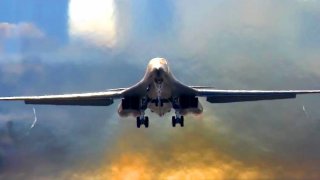B-1 Bombers and Troops Are Heading to Guam (China Is The Reason Why)
And that's not all: Since the departure of the B-52s bombers from Guam on April 17, the Air Force has made its B-1s quite visible in the region and that has included missions that were flown from bases in the continental U.S. That included a 32-hour flight from Ellsworth Air Force Base in South Dakota to the South China Sea and back last week, while earlier in April two B-1s were sent from South Dakota on a 30-hour round trip flight to Japan, where the bombers were joined by U.S. F-16s along with Japan Air Self Defense Force (JASDF) F-15 and F-2 fighters in a joint training exercise.
Last month the United States Air Force conducted an "elephant walk" of its military aircraft on Guam to highlight America's significant military presence in the region before sending its five B-52H bombers back to their home station at Minot Air Force Base, North Dakota. That had reportedly brought an end to the Continuous Bomber Presence Mission, which had seen a rotation of B-52, B-1B "Bone" supersonic bombers and B-2A Spirits for half-year stints on the island, which is located about 1,800 miles east of China.
The program was nixed in favor of "less predictable" global deployment, and what was likely not predicted was that the U.S. military would quickly deploy four B-1B Lancers heavy bombers and hundreds of troops to the western Pacific territory to carry out a "deterrence mission" aimed at Beijing.
The U.S. Strategic Command announced that the B-1B Lancers were deployed to conduct bomber task force operations out of Andersen Air Base, Guam. The four bombers and approximately 200 Airmen from the 9th Bomb Squadron, 7th Bomb Wing, Dyess Air Force Base, Texas, were deployed to support Pacific Air Forces' training efforts with allies, partners and joint forces. The bombers will conduct strategic deterrence missions to reinforce the rules-based international order in the Indo-Pacific region.
"Deployments like this allow our Airmen to enhance the readiness and training necessary to respond to any potential crisis or challenge across the globe," said Col. Ed. Sumangil, 7th BW commander. "It also provides a valuable opportunity to better integrate with our allies and partners through joint and combined operations and exercises."
Since the departure of the B-52s bombers from Guam on April 17, the Air Force has made its B-1s quite visible in the region and that has included missions that were flown from bases in the continental U.S. That included a 32-hour flight from Ellsworth Air Force Base in South Dakota to the South China Sea and back last week, while earlier in April two B-1s were sent from South Dakota on a 30-hour round trip flight to Japan, where the bombers were joined by U.S. F-16s along with Japan Air Self Defense Force (JASDF) F-15 and F-2 fighters in a joint training exercise.
"The B-1 is able to carry a larger payload of Joint Air-to-Surface Standoff Missiles and a larger payload of 2,000-pound class Joint Direct Attack Munitions," said Lt. Col. Frank, Welton, Pacific Air Forces' (PACAF's) chief of operations force management. "Additionally, the B-1 is able to carry the LRASM (Long Range Anti-Surface Missiles), giving it an advanced stand-off, counter-ship capability. It also has an advanced self-protection suite and is able to transit at supersonic speeds to enhance offensive and defensive capabilities."
B-1s were last deployed to the region in 2017 when bombers from the 9th Expeditionary Bomb Squadron supported missions from Andersen AFB; and conducted multiple sequenced bilateral missions with the Republic of Korea Air Force and the JASDF.
"Our wing has conducted, and participated in, a variety of exercises over the last year to ensure we are primed for large-scale missions such as this one," said Sumangil. "We're excited to be back in Guam and proud to continue to be part of the ready bomber force prepared to defend America and its allies against any threat."
The Air Force has not specified how long the bombers will remain in Guam, but that is likely in an effort to remain less predictable.
Peter Suciu is a Michigan-based writer who has contributed to more than four dozen magazines, newspapers and websites. He is the author of several books on military headgear including A Gallery of Military Headdress, which is available on Amazon.com.

